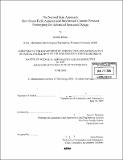The second skin approach : skin strain field analysis and mechanical counter pressure prototyping for advanced spacesuit design
Author(s)
Bethke, Kristen (Kristen Ann)
DownloadFull printable version (25.99Mb)
Alternative title
Skin strain field analysis and mechanical counter pressure prototyping for advanced spacesuit design
Other Contributors
Massachusetts Institute of Technology. Dept. of Aeronautics and Astronautics.
Advisor
Dava J. Newman.
Terms of use
Metadata
Show full item recordAbstract
The primary aim of this thesis is to advance the theory of advanced locomotion mechanical counter pressure (MCP) spacesuits by studying the changes in the human body shape during joint motion. Two experiments take advantage of three-dimensional laser scan technology to measure the shape changes of the human body. The first experiment is an analysis of the surface area and volume of the thigh, knee, calf, and entire leg during knee flexion. The second experiment is an analysis of the full-field strain on the skin surface of the leg during knee flexion. A repeatable and quantitative technique for mapping the leg skin strain field is developed. The results of the algorithm indicate the magnitude of strain over the entire surface of the leg, as well as the direction of minimum leg skin stretching during knee flexion. For 88% of the leg surface, knee flexion causes skin strain between -0.3 and 0.3 (less than 30% contraction or extension). However, just below the patella, longitudinal strain is as high as 0.7, and at the knee hollow, it is as low as -0.6. Circumferential strain values are as high as 1.0 and 0.5 just below the patella and over the calf muscle, respectively, and along the anterior surface of the lower leg, they are as low as -0.7. The leg area, volume, and skin strain results lead to quantitative design requirements for highly mobile second skin spacesuits, and they inspire two prototype MCP leg sleeves: a hybrid urethane-foam bladder garment and a skintight nylon fiber lines of non-extension garment. These two prototypes are constructed and tested for mobility and skin surface pressure. Pressurization of the hybrid foam prototype inhibits leg mobility. (cont.) However, the nylon lines of non-extension prototype shows promise as an advanced locomotion spacesuit design concept. During pressurization to leg surface pressure of 7.5 kPa (56 mmHg, 1.1 psi), the prototype preserves easy mobility to 90 degrees of knee joint flexion. Recommendations are made for improving its pressure production performance to the desired 30 kPa (222 mmHg, 4.3 psi) level.
Description
Thesis (S.M.)--Massachusetts Institute of Technology, Dept. of Aeronautics and Astronautics, 2005. Includes bibliographical references.
Date issued
2005Department
Massachusetts Institute of Technology. Department of Aeronautics and AstronauticsPublisher
Massachusetts Institute of Technology
Keywords
Aeronautics and Astronautics.